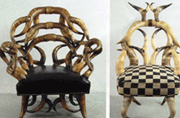|
Horn Furniture and Accessories Make a Comeback
By Anne Gilbert
If you think that furniture made of animal horns began in America in the Old
West, think again. The horn furniture that was made in Germany as early as 1833
first became noticed after it was displayed at the 1851 Crystal Palace Exhibit
in London. Its popularity grew, and by the end of the 19th century, it was being
practically mass produced in the Midwest using horns from the longhorn cattle
that found their way to slaughterhouses in Chicago and Kansas.
It was first
introduced in America at the Chicago Industrial Exposition in 1876 by the Tobey
Furniture Company of Chicago in the form of an upholstered chair and sofa with
horn arms. Soon, they used horns for legs and backs of parlor furniture. It was
an instant success. By the 1890s, it was made in large quantities by Wolf, Sayer
& Heller of Chicago along with hall racks, clock holders and tables. It soon
found its way to the East where it was considered perfect for another craze:
hunting lodges and mountain cabins. It seemed the perfect furniture, conjuring
up images of the Old West and the disappearing frontier.
It was finally made
in the West in 1880 by Friedrich Wenzel, in San Antonio. However, much was
imported from Topeka, Kansas, where it was made in 1886 by a quality furniture
maker, Charles Calwell of Topeka. In a letter left to the Kansas Museum of
History, Calwell described how he began making longhorn furniture. He first
became interested when in 1880 a German furniture maker, Friedrich Wenzel, began
making a variety of horn furniture in San Antonio. In the letter, he related how
the entire family participated in making early pieces for personal use. He and
his wife first made a table, then two rocking chairs, a bookcase and a settee.
His wife polished the horns. Many of these pieces are now in the Kansas Museum
of History.
When longhorns became scarce around 1900, that marked the end of
horn furniture, and until recently, it has been practically forgotten and out of
fashion.
CLUES: Now, once again, there is interest in antique horn furniture.
To the hundreds of people now buying mountain homes and rustic cabins, the
pieces made in the late 19th century and early 20th of real horns are worth the
hefty auction prices. Steer horn chairs can sell at auction for from $2,000 to
$5,000. A chandelier fashioned from antlers can fetch as much as $4,000. If a
piece can be attributed to an actual maker the price will zoom.
Many of the
pieces are quite handsome with imaginative uses of the horns and animal hides.
So many were once made, and sturdy, they probably have survived and await
discovery in a barn or attic.
Since American-made pieces are more in demand,
make sure they didn't originate in Germany or elsewhere.
|

(L) Steer horn armchair, 19th century; (r.) brass-mounted
steer horn
armchair, 19th/20th century; both American.
(Photo: Garth's Auctions,
Delaware, OH.) |